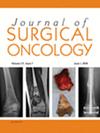Temporospatial Recurrence Patterns and Predictive Factors for Recurrences in 984 Patients With Adult Soft Tissue Sarcomas
Abstract
Background
Soft tissue sarcomas recur despite optimal multimodality treatment. Being rare, and heterogeneous, there is no consensus on follow-up protocol and management of recurrences.
Materials
This is a retrospective analysis of the adult soft tissue sarcoma database. All the patients undergoing curative surgery between 1993 and 2020 were included. We studied the recurrence patterns in terms of time and anatomical location concerning age, gender, site, size, histology, grade and treatment and identified the predictive factors for local (LR) and systemic recurrences (SR).
Results
A total of 984 patients were included. In a median follow-up of 37 months, 31% (305) of patients developed recurrence. Of these, there were 12% LR and 19% SR. The median time to LR and SR was 1.07 years (0.581–2.30) and 1.03 years (0.529−1.80) respectively. The median time to recurrence was least in retroperitoneum, 0.827 years (0.471−2.34), followed by extremity, 1.60 years (0.495–3.73); trunk, 1.95 years (0.696–4.27) and head & neck, 2.21 years (0.909−4.05). Extremity and head & neck STS had more SR, while RP & trunk had a higher rate of LR. Common subtypes associated with LR were extraskeletal chondrosarcoma/osteosarcoma (n = 14, 27.27%), DFSP (n = 5, 26.32%), and leiomyosarcoma (n = 22, 24.44%) and; with SR were rhabdomyosarcoma (n = 4, 50%), angiosarcoma (n = 2, 33.33%), and pleomorphic liposarcoma (n = 23, 27.71%). Recurrence was curatively treated in 32% of patients. The 5-year overall survival in patients with LR and SR were 76.3% and 41.2% respectively. In a multivariate analysis, age > 50 years and extremity site were predictors of local recurrence whereas male sex, high grade, and adjuvant chemotherapy were predictors of systemic recurrence.
Conclusions
The study shows a higher incidence of early LR in RP and late LR in the trunk while a higher incidence of early SR in extremities and late SR in the head and neck. The highest risk for SR and LR is associated with synovial sarcoma and liposarcoma respectively. This pattern of recurrence may guide in individualizing the follow-up frequency and imaging modality as well as in doing the timely intervention.



 求助内容:
求助内容: 应助结果提醒方式:
应助结果提醒方式:


